June 30, 2017
I was recently in the U.K. (London, Dover, Warehorne) with wife Nat and some of my bestest pals, Jon and Nicole. It was a groovy trip (you should visit all three places, right now!), and we had oodles of English fun. At the beginning, in old Londinius, we had a little apartment, and while we visited some swell bars (especially Oriole, which is wonderfully dreamy), we also hung out in the apartment drinking G&Ts. To do it right, the G we used was from the East London Liquor Company, picked up at their stall at the bountiful Borough Market.
The first distillery in London’s east end in over a century, the East London makes vodka, rum, whisky, and of course gin, including their flagship Dry Gin, which is what we had! Made from 100% British wheat and using both vapor and direct infusion of spices, citrus, and juniper, it boasts a clear juniper and lemon/grapefruit taste underlined by cardamom, coriander, and more. Yummy stuff. We also picked up a bottle of 3/4Ounce Tonic Maison tonic syrup – from Montreal! We were very international. The Maison has a steady bit of cinchona bitterness and spices and mingled nicely with the gin. It all made from some wonderful moments, sitting around with good friends sipping while discussing the wonders of London.
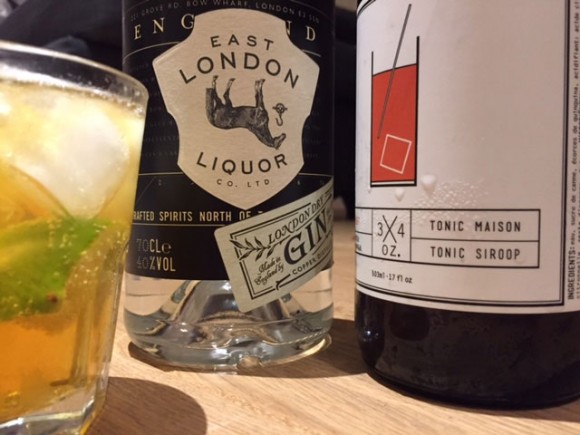
Gin and Tonic
1/2 ounce 3/4Ounce Tonic Maison tonic syrup
1-1/2 ounces East London Liquor Co. Dry Gin
Ice cubes
3 ounces soda water
Lime wedge, for garnish
1. Add the Tonic Maison and East London Liquor Company gin to a brandy snifter (or highball, or whatever glass they have at your rented space, as the case may be). Stir briefly.
2. Add a decent amount of ice to the glass. Top with the club soda. Stir well, but carefully.
3. Garnish with the wedge. Dream of London (or, if you’re there, of Montreal).
Tags: 3/4Ounce Tonic Maison tonic syrup, cocktail, cocktails, East London Liquor Co. Dry Gin, East London Liquor Company, Friday Night Cocktail, Gin, gin and tonic, London is gin-y, Tonic, tonic syrup, What I’m Drinking
Posted in: Cocktail Recipes, Distillery, Drinks on the Road, Gin, Recipes, What I'm Drinking
June 10, 2014
Hello friends! Come have a couple free drinks made by me on June 14th, from 4 – 7 pm. What, you say, free drinks? Yes, I’m hosting a cocktail party at the awesome Zinc Art + Interiors,102 3rd Ave South, Edmonds, WA, on the 14th. I’ll be serving two drinks from
Ginger Bliss and the Violet Fizz, the award-winning Persephone’s Elixiar and the classic Lucien Gaudin – and I’ll be making the latter with the amazing Alpinist gin from the fine folks at the Seattle Distilling Company! I’ll also have two homemade liqueurs from Luscious Liqueurs for you to sample and they’ll be a few tasty treats from Party Snacks. All three books will be on sale alongside the finest art and interiors in the region! If you haven’t been to Zinc (which is packed with swell stuff and run by swell people) this is the perfect chance to go. If you need a drink, this is the perfect time to have one! See you there.

Tags: cocktails with me, drink events, Ginger Bliss and the Violet Fizz, homemade liqueurs, Luscious Liqueurs, party snacks, Zinc Art + Interiors
Posted in: Cocktail News, Drinks on the Road, Ginger Bliss and the Violet Fizz, Luscious Liqueur, Snacks
April 4, 2014
We (wife Nat and I) recently got back from another trip to Italy. Sadly it was two weeks in Italy, and not seven months in Italy, but it was still darn fun. And while there, we stopped to see our pal Diego, the amazing and friendly third-generation vintner at Donini Wines, who I’ve talked about more in-depth like on the Italy blog. Every time we stop by, it’s exactly like visiting a friend combined with what I think every wine tasting should be like. We sit down, he starts opening wine:
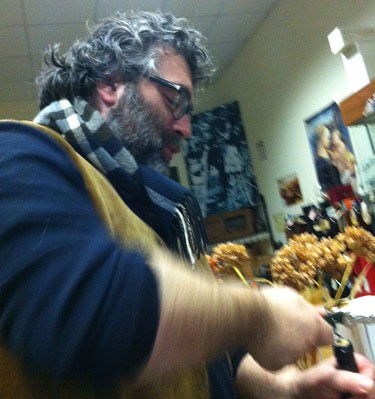
even some unlabeled new bubbly that is fantastic, crisp, clear, and lovely:
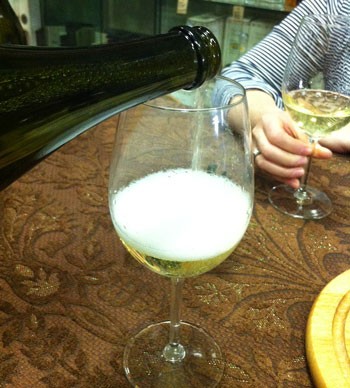
Then he brings out cheese and crackers and more wine:
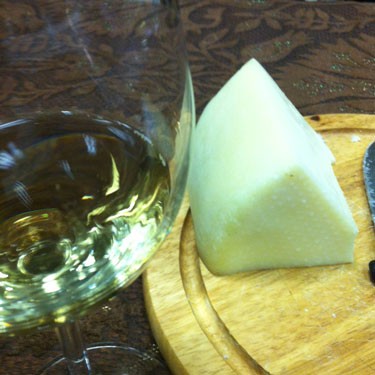
Then opens another bottle of wine:
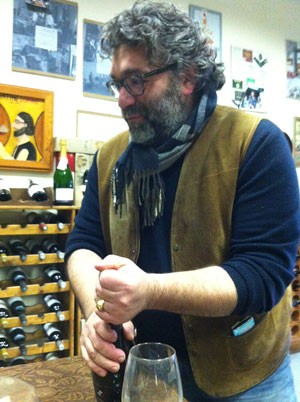
The whole time we’re catching up, talking about wine and the seasons and Italy and America and our families and this and that, and Diego is charming and always opening and pouring more wine for us to try:
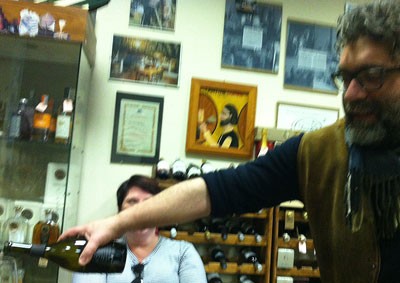
And then the table looks like this (with new reds and whites alongside old friends, all in Umbrian style and all great):
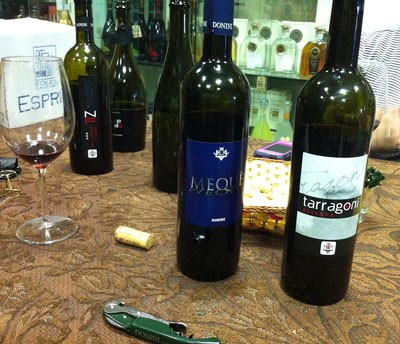
If you’re ever in Italy, especially southern Tuscany or northern Umbria, you should be sure and stop by and see him and Donini Wines, too. Sadly, they’re only imported into the US in Montana and few other select states so far. But you needed a trip to Italy, right? Oh, one thing – you’ll probably need to take some home. So leave room in your suitcase. I always do.
September 10, 2013
In the recent U.K. Drinks Part I post, I talked about drinking ales at Cornwall pubs, and how lovely it was. But I also spent a little time in a town I like to call Londinius (or Matt Berry likes to call it that, and I imitate him), and had some swell drinks there, too. The swellest though, and what I’m devoting this post too, were at a bar with no name that resides at 69 Colbrooke Row (and, funny enough, the check actually says “The Bar With No Name”). It’s a well-known spot, thanks to the bartending and chemistry of renowned shaker Tony Conigliaro, whose book The Cocktail Lab: Unraveling the Mysteries of Flavor and Aroma in Drink, with Recipes, recently came out. You should buy it, if you’re at all interested in cocktails. And why would you be here if you weren’t? Anywho, I’d always wanted to visit said bar, and was stoked to finally get there. I started with a drink called Terroir, which is a word I can’t pronounce. It’s also a straight spirit they distill at the “lab” up the street – distill from clay, lichen, and flint! Really.
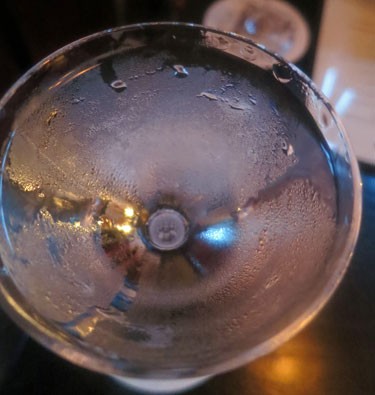
If you see a drink on a menu that’s a distillate of clay, lichen, and flint, how can you get anything else? You can’t. It comes poured at the table straight from the bottle,
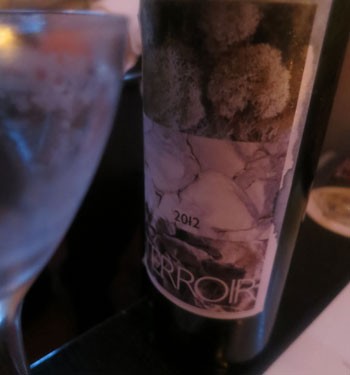
and was delicious, slightly sweet, even, with earth tones, as you’d expect, and undercurrents of the air you smell when roaming the hills of France. From there, I went to the Avignon, on the server’s suggestion (more about said server in a minute). It was a combo of Merlot Cognac, Chamomile syrup, and smoked Frankincense. I kid you not! It had an amazing complex smokiness that started with the glass itself – turns out, they smoke the glass, too, in some mad scientist machine at the lab. The drink had layers of smoke and smelled, almost as if you were drinking from a chasuble.

At this point (and after Nat had a few drinks, which I’m not detailing cause really then you’d know the whole menu and not want to visit the bar yourself, which you should. So I’m leaving you with a bit of mystery) I wanted something a bit more umphy, as both the early drinks, while awesome, had sweeter notions. After talking it through with our server (hold on, more on him in a sec), he suggested an old favorite I hadn’t had in years, the Remember the Maine. A perfect idea! It’s like a Manhattan jagged with absinthe more-or-less, and fell right into place. Sadly, I was having too much fun to take a picture.
But that wasn’t it (and no, we weren’t stumbling – we were there a while, and the drinks were well-sized, meaning not like buckets). On the advice of that same server, and actually on the dime of that server, as he bought us this last drink, we had the Prairie Oyster shot. Now, don’t faint (if you know I’m a veg, that is. If you don’t, now you do). There wasn’t a real oyster involved. What was involved was cool as heck, and I’m going to try and describe it, but not do it justice. But here goes. They take tomato water and herbs, and place it into a handmade mold that looks like an oyster, then immerse it in a chemical solution that makes the outer layer form into a “skin” of sorts, and the whole thing look oysterish. Then they place it into a custom-made ceramic “shell” and top it with house pepper vodka and some other goodness. Then you shoot it. When you take a bite (which I suggest) of the tomato “yolk” or “oyster” it bursts with this fantastic rush of vegetal-ness, herb and spice, and pepper. It’s yummy.

So, the drinks were interesting, tasty, and reliable. Which wouldn’t mean nearly as much if the service wasn’t so darn great. Everyone working there was friendly, the place itself is cozy, there was a piano player knocking out 1930s, 40s, and 50s hits, there’s a Bogart-y shadow on the wall going up the bathrooms:

and the whole atmosphere is neat. And our main server was super helpful, so enthusiastic about the drinks, as well as knowledgeable, and very friendly. He greeted every table with a “Hello Ladies and Gents” and kept everyone happy, with the help of the other amiable employees. And, his name was Coco.
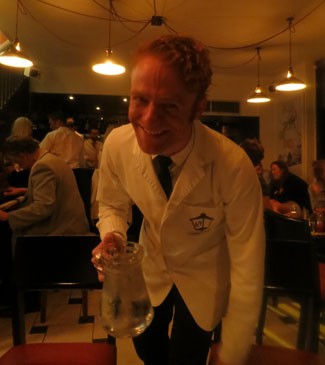
He told us he’s opening his own bar in London soon, so when you visit 69 Colbrooke Row, which you must, ask them where Coco’s bar is, so you can visit it, too.
Tags: 69 Colbrooke Row, Avignon, Bars, cocktails in London, Coco, crazy chemistry drinks, Drinks on the Road, London bars, Prairie Oyster, Terroir, Tony Conigliaro
Posted in: Bars, Cocktail News, Drinks on the Road
September 3, 2013
We (wife Nat and I, that is) were recently in lovely England for a wedding – our friends Becs and Drew (who wrote a number of dandy Drew’s Brews columns for this very site) got hitched down in Falmouth, Cornwall. Since we were down in that beautiful part of the world, we stayed on for a while after the wedding, in a spot near Port Isaac, where Doc Martin is filmed. Yes, I am square. While in the English countryside, we saw many amazing vistas, caught up on some history, drove on some very tight roads, ate a host of tasty meals, and sampled a fair number of real, or cask ales. Though this site is usually about cocktails and spirits, I also (don’t gasp) like the ales, lagers, stouts, and general beers. Which meant that our English beer-cation was right up my alley. And so I thought I’d highlight a couple favorites. Out first hit, which to be honest was a hit for many days, was the award-winning Tribute Cornish pale ale, from St. Austell brewery. It’s made (I discovered) from 100% Cornish Gold Malt, and has a biscuity, malty flavor, with hints of citrus:
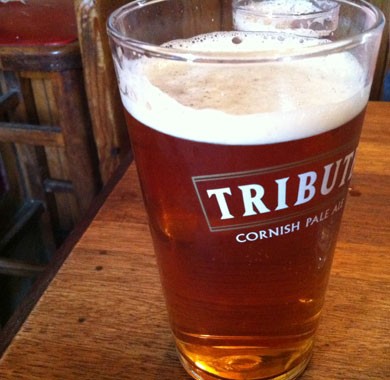
I also had a few Proper Jobs, which was a favorite of Becs and Drew that they suggested we try. It was a good suggestion. Also from the St. Austell brewery, it’s a hoppy hoppy IPA with the right amount of bitterness:
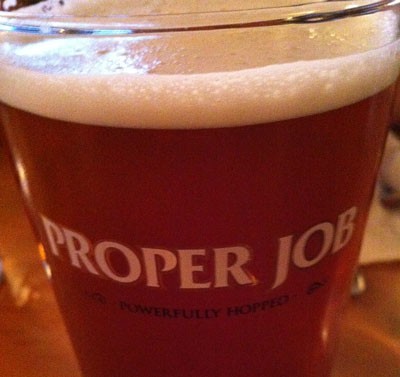
We went to a lot of dandy pubs (most of which not only have intriguing beers, but really better-than-expected food, too), including the Blisland Inn, which is owned by a fella nicknamed King Buddha, and he has his own beer only available there (I think), the King Buddha Blisland Special from Sharp’s brewery, which I was happy to try. It also had a great English ale taste, a stitch bitter, and was a good accompaniment to a hearty lunch:
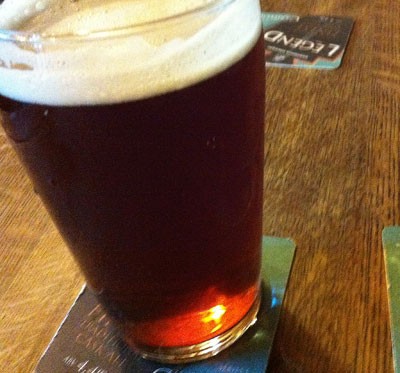
Eventually, we found our way to London, at which time we moved into the Fuller’s family of beer. Both because it’s Nat’s last name and because Fuller’s Ales are darn fine, especially the classic London Pride, which is smooth, creamy, malty, and wonderful:
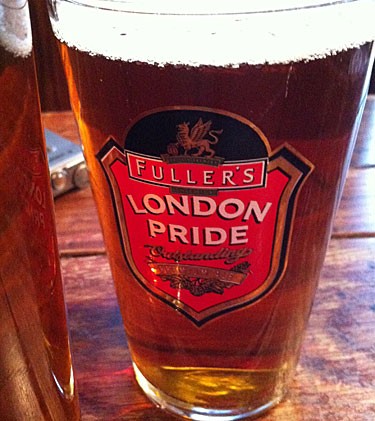
Now, get yourself over to the U.K. and have your own beer-cation.
May 24, 2013
Beyond Blackbird (which I detailed earlier and which I was a big big fan of), when I was in San Francisco recently I also stopped in at Absinthe Brasserie and Bar. First off, let me mention that I accompanied the wonderful and charming Sally and Corinne from the Lisa Ekus agency (the best agent, pr, media training, and more firm in the firmament) and some other folks associated with that fine orgnaization. If you have company like this, well, the restaurant or lounge you’re lounging in can probably serve almost anything and you’ll have a dandy time. However, if the drinks are as good as they were at Absinthe, the evening goes quickly up to wonderful. I started my drinking with a Ginger Rodgers, which is a variation on a drink called, simply, “Favorite Cocktail” from the classic pocket-sized cocktail book Drinks, written by Jacques Straub in 1914. It was everything a first drink before dinner should be: light-but-flavorful, bubbly, and a good appetite inducer:
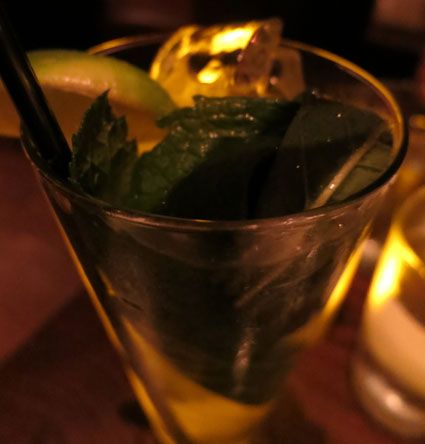
After that, I was eating some delicious food (the mac-and-cheese was especially nice – and I should have taken a pic but was too busy eating and talking), and wanted something with a lot of flavor to accentuate the edibles. I went with a classic: the Pegu, from way back in the 1920s. It was tasty, tangy, and with a kick:
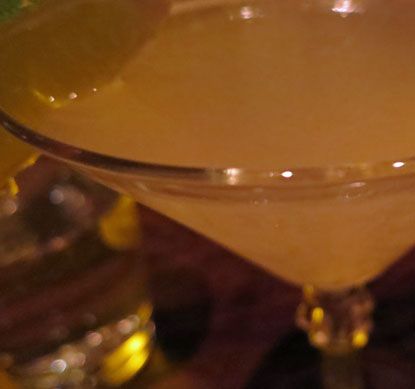
Heck, you should have one at home if you never have. It’s famous and fabulous. Here’s the recipe from Ginger Bliss and the Violet Fizz:
Ice cubes
1-1/2 ounces gin
3/4 ounce Pierre Ferrand orange curaçao
1/2 ounce freshly squeezed lime juice
Dash of orange bitters
Dash of Angostura bitters
1. Fill a cocktail shaker halfway full with ice cubes. Add the gin, orange curaçao, lime juice, and both bitters. Shake well.
2. Strain into a cocktail glass, and dream of days when this classic was (according to Harry Craddock in The Savoy Cocktail Book) a drink “that has traveled, and is asked for, round the world.”
After the Pegu, I had something with whiskey that I forgot to write down as the conversation was in full swing. But it was good, so just try all the whiskey drinks and you’ll get there. Here’s a photo, anyway:
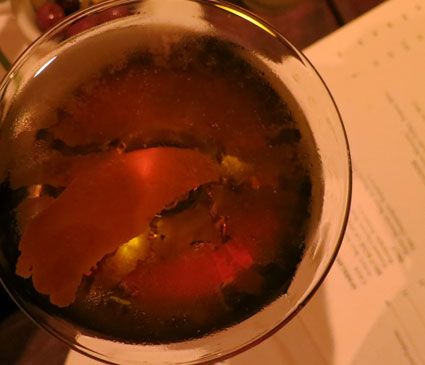
Overall, an amazingly awesome evening spent with some of the swellest folks in the land, some delicious cocktails, and some scrumptious eats in a classy-but-comfy spot. Absinthe gets a “A” in my book (if I had some sort of book I put letters in, that is).
Tags: absinthe, Bars, cocktail recipe, Cocktail Recipes, Drinks on the Road, Fright Night Cocktail, Gin, Ginger Bliss and the Violet Fizz, Ginger Rodgers, Lisa Ekus group is awesome, orange curaco, Pegu cocktail, San Francisco, What I'm Drinking
Posted in: Bars, Cocktail Recipes, Drinks on the Road, Gin, Ginger Bliss and the Violet Fizz, Liqueurs, Recipes, What I'm Drinking
May 14, 2013
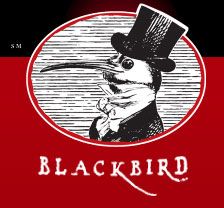 I recently was lucky enough to spend a short two days (not lucky cause it was short, but lucky in that I was able to go at all) in San Francisco, checking out a few snazzy bars and seeing some snazzy people. And having some Mexican food with my pals Mike and Meredith. But here, cause in theory this is a blog about booze and drinks, I’m gonna focus mostly on pictures of the drinks I had, starting with ones had at Blackbird. From what I’ve gathered, Blackbird is sort-a new, though it had a very comfortable neighborhood bar feel and a bunch of stuffed blackbirds above the wooden and glass shelves behind the bar. I don’t want the term “neighborhood” to confuse you though, into thinking the drinks weren’t crafted with care. Cause they were, and then some, by a bartender named Matt Grippo (and a couple other nice fellas whose names I missed). The menu was scripted on a long big scroll-of-sorts behind the bar (in two spots), and I picked a Knee Slapper off of it:
I recently was lucky enough to spend a short two days (not lucky cause it was short, but lucky in that I was able to go at all) in San Francisco, checking out a few snazzy bars and seeing some snazzy people. And having some Mexican food with my pals Mike and Meredith. But here, cause in theory this is a blog about booze and drinks, I’m gonna focus mostly on pictures of the drinks I had, starting with ones had at Blackbird. From what I’ve gathered, Blackbird is sort-a new, though it had a very comfortable neighborhood bar feel and a bunch of stuffed blackbirds above the wooden and glass shelves behind the bar. I don’t want the term “neighborhood” to confuse you though, into thinking the drinks weren’t crafted with care. Cause they were, and then some, by a bartender named Matt Grippo (and a couple other nice fellas whose names I missed). The menu was scripted on a long big scroll-of-sorts behind the bar (in two spots), and I picked a Knee Slapper off of it:
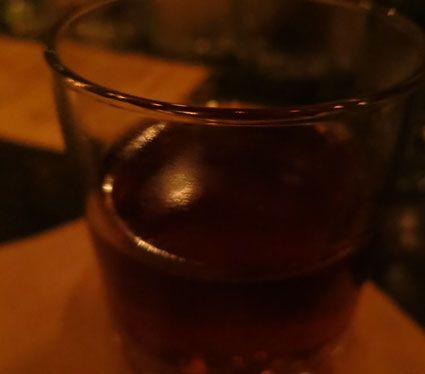
The Knee Slapper (well-named, as most drinks there) was a combination of Four Roses, Old Overholt rye, Averna, Gran Classico, and, interestingly, crème de cacao. It’s rare to see a doubling of the base spirits, and rarer still to see the crème de cacao thrown into a mix of brown boozes, but the end result was very tasty, rich, and layered with flavor and herbal notes. Dreamy stuff. By the time I ended up with a second drink, the Blackbird was hoppin’. It was a Saturday night, so expected, but I haven’t been in a spot that busy for a few, oh, years probably (hey, I’m old). It was four deep across the whole bar at one point. And here’s what was amazing: Matt kept his easy-going and affable demeanor the whole time, even when people asked incredibly silly things (one order: “can I get four beers, a Martini, and some whiskey?” With no specifics at all). And, during the madness, the drinks were still put together perfectly, and including an off-menu drink he made for me (maybe it was going to be on the next menu) with no name – or no name I remember. It was a wildly intriguing mixture as well: Enchanto pisco, Calpico (an uncarbonated Japanese milky soft drink), cucumber, lemon, orgeat, and a rose water rinse. That is out there friends. But you know what? It all came together into a refreshing, tangy, vegetal, smooth hit:
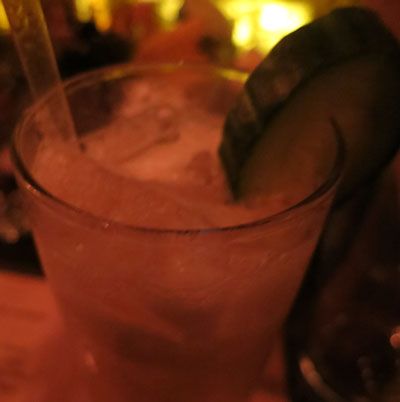
All-in-all, a fantastic spot, Blackbird. I’d definitely return in a heartbeat. It’s the kind of place where you could get the fancy cocktails made in the modern masterful manner, but also order a High Life if you wanted – as long as you paid cash:

May 20, 2011
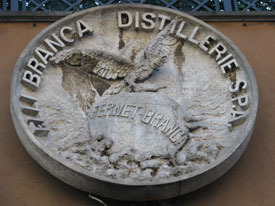 Back in April (when still living in Italy), wife Nat and I took the road north from our Italian pre-tirement home, driving up to Milan so we could make a visit to the Fratelli Branca Distillerie, where Fernet Branca and many other delicious drinkables are made. When we showed up in the morning for our tour, we weren’t sure at all what to expect—a little talking, a little walking around the building, we just didn’t know. But it ended up being an amazing day, where we learned a ton and had some fun (huge props to Laura Baddish for helping to set it up, too). Once past the guards (serious liqueurs always need guards at the gates, cause secret formulas are too tempting to weaker minded individuals), we were met by three swell Italian folks: Elisa, Marco, and Valeria. Marco gave most of the tour, with tons of expert translating (his English is better than our Italian, but not by enough to carry on in-depth conversations) and more touring by Elisa, with Valeria filling in the cracks.
Back in April (when still living in Italy), wife Nat and I took the road north from our Italian pre-tirement home, driving up to Milan so we could make a visit to the Fratelli Branca Distillerie, where Fernet Branca and many other delicious drinkables are made. When we showed up in the morning for our tour, we weren’t sure at all what to expect—a little talking, a little walking around the building, we just didn’t know. But it ended up being an amazing day, where we learned a ton and had some fun (huge props to Laura Baddish for helping to set it up, too). Once past the guards (serious liqueurs always need guards at the gates, cause secret formulas are too tempting to weaker minded individuals), we were met by three swell Italian folks: Elisa, Marco, and Valeria. Marco gave most of the tour, with tons of expert translating (his English is better than our Italian, but not by enough to carry on in-depth conversations) and more touring by Elisa, with Valeria filling in the cracks.
The tour started in the Collezione Branca, which is a museum created by the Branca family, a museum in the distillery (the aromas of Fernet Branca and other drinks waft up as you wander the museum), collecting Branca historical items, memorabilia, and more. It really serves as a tangible history of the company in many ways, and was full of intriguing artifacts. Right at the beginning are portraits of those family members who were there at the beginning, with a picture of Bernardino Branca in the middle:
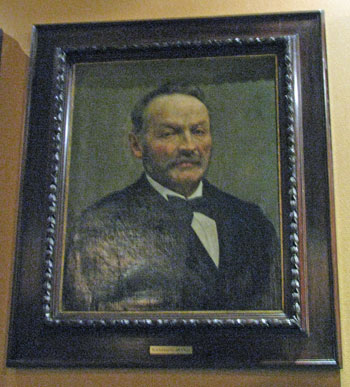
Bernardino was the original creator of the famous Fernet Branca, developing the formula with Dr. Fernet, a Swedish doctor, to assist malaria and cholera patients. With this aim, it was first tested in hospitals (where it was shown to help patients) and first sold in local farmacias, or pharmacies (quick aside: Italian pharmacists have a lot more leeway than those here in the States, in prescribing and diagnosing). The first cask that Bernardino made this herbal health mixture in is also in the museum, and lives right under his portrait:
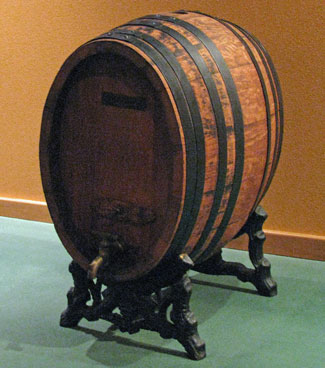
When walking through the museum, we learned more about the Branca family, which still runs the company today (the head of the company, Count Niccolo Branca, is the 5th generation of the family to make Fernet Branca). The family focus isn’t just with the Brancas, either, as our tour guide Marco is the 4th generation of his family to work at Branca (he’s been there since 1972). This lengthy dedication and devotion is quite remarkable, and shows in the end results: the liqueurs. There are lots more interesting family stories, such as those about Maria Scala, who married the third son of Bernardino and eventually became one of the first women in charge of a large company, and who originally developed the focus on continually creative Branca advertising—the company has always been on the forefront of advertising and advertising trends. One of my favorite, and a somewhat obscure, piece of marketing is this Branca suitcase:
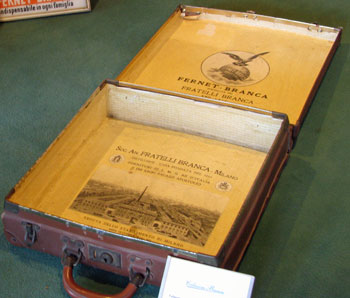
I would carry one of those in an instant (if you have one you’re tired of, please let me take it off your hands). The museum also has loads of production implements from the past, and some that were used in the past but are still utilized today, which points towards the Branca philosophy of novare serbando, or renew but conserve. For one example, Marco showed us these giant iron pots for herb maceration and heating, which are still used today, though the stirring is done mechanically instead of by hand:
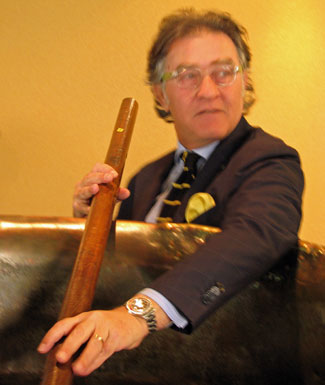
The pots were at one point stirred with both iron and wood stirrers (depending on the spices), and as the iron sticks were “cleaning” the pots, many thought that Fer-net came from some rendition of “clean iron.” Which is, I have to say, a great story. Fernet Branca gets its signature bitter, herbal, rich taste from an wide assortment of herbs, roots, spices, and other ingredients, and there’s a giant, mind-blowing, round table in the museum where you can see the complete layout of ingredients:
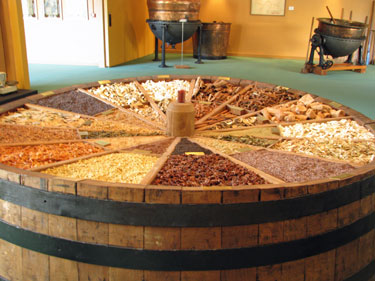
I knew (hey, I’ve done a little research before) that there were around 40 ingredients, and that the list included such far-reaching items as gentian root, rhubarb, myrrh, cinchona bark, galanga, saffron, and others, but I learned while there that all the products used are completely natural, and that all the suppliers have to sign a code of sorts, that says the products were obtained in a non-exploitive way. Another (and this was fascinating to me, but hey, I’m interested in odd things) fact I learned is that the real secret in the secret recipe for Fernet-Branca is how the ingredients are treated in production. Only the family knows, and the Count himself still does the treating (which means he has to go to the other distillery, in Argentina, regularly). Cool, isn’t it? After spices, we got to see tons of hip old Fernet-Branca ads, including the first one to use the eagle-over-the-world logo:
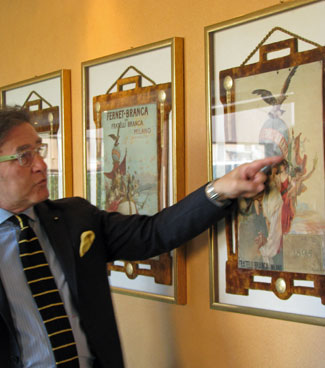
This logo was created in 1895, due to the large amount of Fernet Branca imitations being shuffled out of back alleys—always look for the eagle bringing the Branca over the world to ensure you get the real thing. There are a number of side rooms along the museum’s main path, where you can get a better picture of how Branca workers worked back in the day (as they say), with an herbalist’s room, chemist’s room:
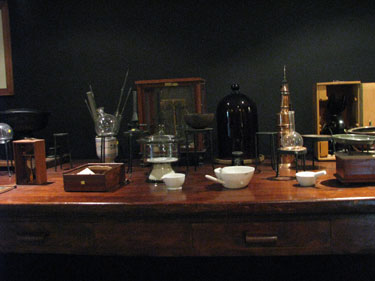
and more. The museum is persistent in remembering not just what was made, but those who made it—not to mention that the museum itself was built by current workers at the plant. Again, there’s that whole atmosphere of devotion to people and product, to stories and to history. After looking over the production process, the spices, and hearing about the history contained within, we walked into a room full of bottles, whole tables of old Fernet Branca bottles, and bottles of other products brought out by the company, including older bottles of Branca Menta (a minty-er and sweeter version of Fernet Branca released in 1965), bottles of Carpano Antica (Branca bought the Carpano company years ago in a particularly astute moment—Carpano Antica being the first Italian vermouth, and one still made partially by hand, and the Carpano company also making Italian vermouth Punt e’ Mes), and more bottles. There’s even a whole cabinet of Fernet Branca impersonators (I suppose success always leads to imitation):
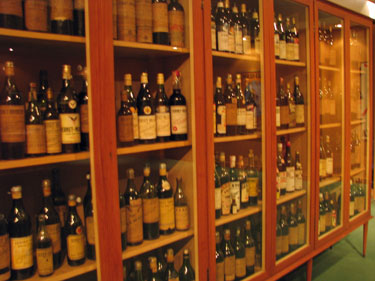
Then we stopped in the bar room (of course the museum was going to have a bar at some point), talked a bit more about advertising, had some Carpano Antica (which I loved even before stopping, and which I was happy to have a glass of even at 11:30 AM), and saw a host of happening ads for the non-Fernet-Branca-Branca brands. If the tour ended now, I would have been more than happy–but we still had the actual distillery to see! Which I’ll talk more about in Part 2, so come on back. Oh, first, check out this sweet and colorful Punt e’ Mes ad (one of about, say, 96, that I wished I had on my walls at home):
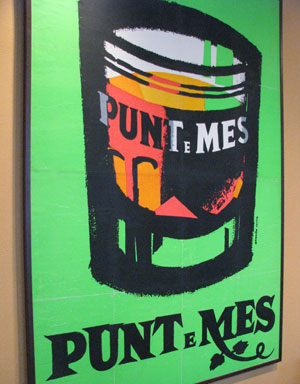
Tags: amaro, Branca Menta, Carpano Antica, Fernet Branca, Fratelli Branca Distillerie, Italian Liqueurs, Italy, Milan, Punt e' Mes
Posted in: Cocktail Art, digestif, Drinks on the Road, Fernet Branca, Italy, Liqueurs
























































